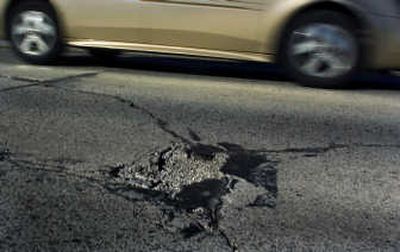Work awaits engineers

Spokane Valley’s list of road projects is ripe with state and federal grants.
Spending that money, though, and overseeing the work has eclipsed the manpower in the city’s small public works department, which also faces several job openings for highly coveted engineers.
The city currently lists about $29 million in funded projects, said City Manager Dave Mercier.
“It just takes more hands on deck to manage those than we currently have,” he said.
The City Council recently voted to add three more public works employees, whose salaries the city can recoup from the projects they work on.
Managers also are trying to fill existing openings for a capital projects engineer and a storm water engineering position that’s been available since May.
“Our experience is similar to that of other municipal, county, public-sector entities in that we’re all involved in almost continuous recruitment for engineers,” Mercier said.
Outside of City Hall, the problem shows itself in one of the most noticeable things the city does – build infrastructure.
Work on a crumbling section of Appleway Road in Greenacres was originally scheduled to start in 2005 but construction won’t begin until next summer.
City officials had said work on an extensive overhaul of the Pines/I-90 interchange and nearby streets would start last summer, but the bulk of the construction is now scheduled for next year.
A new bridge over the Spokane River for Barker Road has been held up as well.
Problems acquiring right of way, lengthy environmental studies and other factors contributed to the delay of recent projects. But the size of the city’s public works department has also been a factor.
“Money is not the reason they have not been doing the things they’re supposed to be doing,” said Steve Stamatoplos, who worked as an engineering technician for Spokane Valley and recently took a job in the private sector.
“They’ve performed as well as any agency and better than most” when it comes to acquiring grants, he said, and the city also has been setting aside a portion of its general fund in reserves.
Therefore it puzzles the city’s former union president why Spokane Valley had a staff of seven assigned to public works projects when other cities of comparable size rely on departments several times bigger.
The City Council’s philosophy since the beginning has been to assign as much work as possible to private firms or Spokane County while keeping the city’s payroll short.
But because engineering services are awarded based on a firm’s qualifications rather than how low its bid is for the work, Stamatoplos questions whether the contracts are really more efficient than doing things in house.
The city manager said that depends.
As the city evolves, Mercier is tasked with hiring enough engineers to handle all of the work while having no way of knowing how much of the federal and state money that pay for the majority of road projects will be available in the future.
For now, he said, it still makes sense for city employees to manage projects that are designed by outside companies, although an in-house design team might make sense in the future.
“It’s been a struggle,” said Mayor Diana Wilhite. “Our staff has done a yeoman’s job of putting in extra hours just to keep up with it,” she said.
Additionally, the companies the city contracts with have a number of projects competing for their time and a shortage of engineers to do the work.
“If they take us on, we become low man on the totem pole,” Wilhite said.
Even as the city finds a balance between workload and the number of employees, Wilhite said she still sees the city’s engineers primarily supervising private contracts.
Meanwhile, the 60-year-old section of Highway 10, now Appleway Road, that runs in front of the Greenacres shopping center still has weeds growing through the cracks. Even though there’s money to fix it, the city couldn’t resolve a dispute over its payment for extra right of way in time.
“It was in that shape when I was a kid,” said Brian Coe, 41, co-owner of Horse and Habit. “It’s definitely one of the worst roads around, by far,” he said.
Although the city also owns the deteriorating parking lot in front of the strip mall that could use some repairs, Coe said customers rarely complain about the road.
Nor has he heard much about the project recently. The latest word on the street, he said, was that it had been delayed because of a problem with the funding.